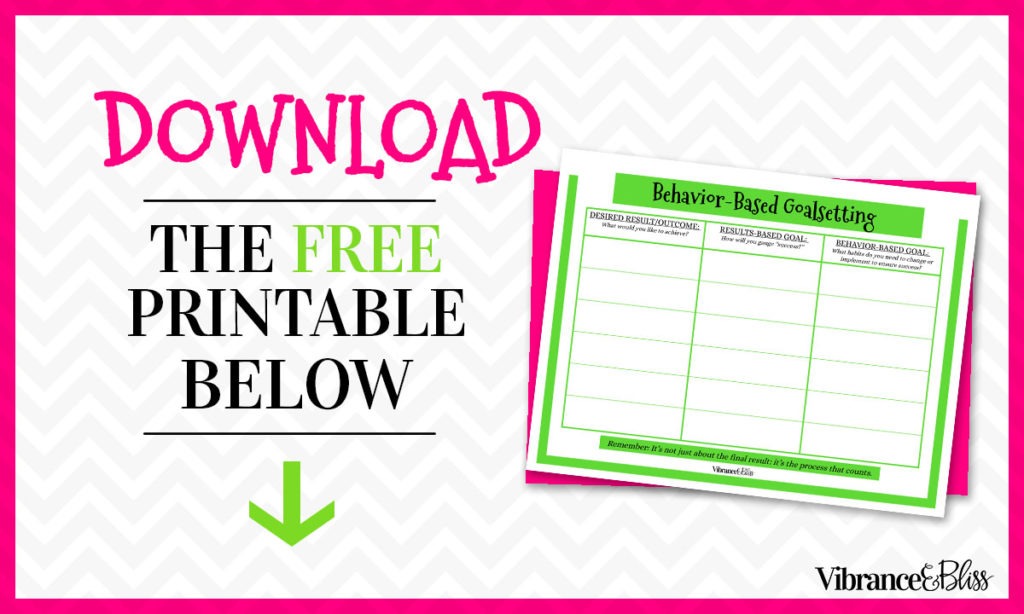Do you find yourself making the same goals year after year, but not actually accomplishing them? How great would it be to actually see a little of your own personal version of success?
I’ve made a lot of goals over the years, and I’ve learned that if you want to set yourself up for real, lasting success, you need to combine your regular goalsetting practices with behavior-based goalsetting.
What is Behavior-Based Goal Setting?
Think for a moment about how you currently set and track your goals. Are they based on your desire to achieve a specific result? Chances are, the answer is yes.
Goals that are based purely on outcome are called results-based goals, and they usually involve a desire to change our living conditions: A promotion at work, spending less money, a newer car, cooking more healthy foods ... all of these are results-based goals because they aim to change our circumstances.
But there is a different type of goal that doesn’t focus on the result at all. Rather than focusing on WHAT we want to achieve, this goal is more concerned with changing our behaviors, which make achieving the results we want easier and far more sustainable. These are called behavior-based goals, and in making positive changes in our habits, (or behaviors), we are in essence creating stepping stones on our way to our ideal outcome.

Positive & Lasting Improvement
Results-based goals tend to focus on the things you do and the actions you take. Behavior-based, on the other hand, ask you to change how you think and act in certain circumstances. It’s more intrinsically motivating than outwardly rewarding- you have to look at how you’re acting and reacting to your world- not just what comes out of those actions.
On the other hand, because behavior-based goals are so internally based, it makes it really difficult to measure and evaluate, especially while you’re still in the middle of progression. With result-based goals you can count the number of meals you make a week, and you can track the money you spend and if you achieved that desired promotion. “Success” is very black and white. This is why we tend to (more often than not) make results-based goals. After all, we like to see progress add up, don’t we?
Many times, when we set goals, we focus on the negative- what we don’t want rather than what we do want. Behavior-based goals focus more on the behaviors we want to strengthen & grow, rather than the negative actions we want to remove. In strengthening the positive behaviors, we change the way we act- it goes beyond putting a band-aid on the situation that we’ll just have to fix again later.
Let’s say you make a goal to lose 20 lbs. A few months later, you’ve worked hard enough to achieve that goal! (Go, you!) You’re finished now, right? Hard work over?
If only! If you lost that weight using a fad diet or weight-loss product, as soon as you quit using those items, won’t the weight just return? Instead, you need to change your behavior- you need to create healthy habits like eating well and moving your body. You need to create systems in your life that you can live with, permanently, so you don’t fall back into your old ways.
Results & Behaviors: Working Together
Results-based goals are not inherently bad, and behavior-based goals aren’t necessarily “better”. They’re both necessary, but I think people tend to only be concerned with the goals that give them quick results. Common goalsetting practices don’t normally include both result & behavior-based goals, which when they work synergistically together, they go beyond the surface and really help you change your life in the most positive, productive way.
When & How to Utilize Behavior-Based Goals
If you’re having trouble meeting a results-based goal you’ve set for yourself before, think about the possibility of changing a habit or behavior in your life instead. For instance, if you set a behavior-based goal to increase your productivity but spend all morning on Facebook looking at cat videos, you’re not really going to accomplish much, are you? That’s how behavior-based goals can help – your “results-based” goal is valid & honorable- you just need to figure out how to cut the Cat Video Distraction once and for all.
It’s a lot simpler than you think to link your results-based goals with your more intrinsically motivated behavior-based goals.
- First just decide what you want to achieve, long-term. These are your traditional results-based goals that you’re probably already used to making.
- Then ask yourself: “What positive habits will I need to create in order ensure this goal is not only met, but also sustained?”
Whatever habits you need to make or actions you need to take will become your behavior based goal. See how they work together?
Examples of Behavior-Based Goals
So what kind of goals can you set? Below are some examples of what behavior-based goals can look like, but just know that any goal that helps you look at your attitudes and internal motivations & behaviors will probably work. This list is certainly not exhaustive, but will help you get an idea.

Hopefully you can see the beauty of combining behavior-based goals with results-based goals. By utilizing them both, your chances of achieving your desired result, and sustaining the positive changes you’ll begin seeing all throughout your life as a result, are much greater than by using just one of them alone.
FINISHING THOUGHTS
Whatever your goals, whether you aim to get more done, get out of debt, make new friends, or lead a healthier life, I hope you’ll try setting a few behavior-based goals of your own and I promise that by carefully developing them, it won’t be hard to see the benefits add up.
Want to evaluate goals of your own? Download the FREE printable below to get started!
GRAB YOUR FREEBIE!
Don't forget to download the free printable! You'll find it in the free resource library. after signing up below!

Next Steps:
Interested in more tips to become more productive, manage your time and organize your schedule? Sign up for my FREE course: "Transform the Overwhelm: 7 Days to Peaceful Productivity".














